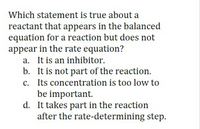
Chemistry
10th Edition
ISBN: 9781305957404
Author: Steven S. Zumdahl, Susan A. Zumdahl, Donald J. DeCoste
Publisher: Cengage Learning
expand_more
expand_more
format_list_bulleted
Question

Transcribed Image Text:Which statement is true about a
reactant that appears in the balanced
equation for a reaction but does not
appear in the rate equation?
a. It is an inhibitor.
b. It is not part of the reaction.
c. Its concentration is too low to
be important.
d. It takes part in the reaction
after the rate-determining step.
Expert Solution
This question has been solved!
Explore an expertly crafted, step-by-step solution for a thorough understanding of key concepts.
This is a popular solution
Trending nowThis is a popular solution!
Step by stepSolved in 2 steps

Knowledge Booster
Learn more about
Need a deep-dive on the concept behind this application? Look no further. Learn more about this topic, chemistry and related others by exploring similar questions and additional content below.Similar questions
- Your friend Niko predicts that iron and silver nitrate will form when silver is placed into an iron (III) nitrate solution. Is this correct? Why or why not? Reactivity Series of Metals K Ca Na Ma Al Zn Fe Ni Sn Pb Cu Ag Au Most reactive Least reactivearrow_forwardPls help ASAP. Pls do the questions looking at the info given.arrow_forwardChoose all of the given components that should not be included in a Materials and Methods/Experimental section of a research article. tables of data identifying the amount of product formed by chemical reactions being studied the claims that the author wants to make regarding the research the conclusions that can be made from the data taken in the research project the types of instruments and devices used to conduct the research why the particular instruments were used to conduct the research tables of data identifying the amount of each reactant in the research project figures that include the data collected in the research project O O Oarrow_forward
- How many moles of W are needed to react with 1.0 mol of Ho in the hypothetic chemical reaction? 3W + 2Ho → 2W3Ho a. 0 b. 1.5 c. 2 d. 3 e. 1arrow_forwardUse the chemical equation to find the answers. H2CO3 → H2O + CO2 Identify how many oxygen atoms are in the product. Identify how many oxygen atoms are in the reactant.arrow_forwardClassify each chemical reaction: Reaction 2Na(s) + Cl₂ (g) 2NaCl(s) 2Li(s) + 2HCl(aq) 2LiCl(aq) + H₂(g) H₂CO3(aq) → H₂O(l) + CO₂(g) K₂SO₂(aq) + Ba(NO³)₂(aq) → 2KNO3(aq) + -BaSO (s) Type choose one choose one choose one choose one X S >arrow_forward
- Write the equation for the decomposition of aluminum chlorate. Group of answer choices Al(ClO3)3 → AlCl3 + O2 2AlClO3 → 2AlCl + 3O2 AlClO3 → AlCl + 3O2 AlClO3 → AlCl + O2 2Al(ClO3)3 → 2AlCl3 + 9O2 Al(ClO3)3 → AlCl3 + 9O2arrow_forward24arrow_forwardConvert the word into formula equations, add states, balance and classify Solid copper(II) chloride with elemental hydrogen → solid copper and hydrogen chloride gas: classify: _________ Solid aluminum with (aq) copper(II) nitrate → (aq) aluminum nitrate and solid copper classify: _________ Classify these and all other reactions below by changes in composition (COM, DEC, and/or SDP, or DDP), and as redox (R/O) and combustion (CMB), if applicable.arrow_forward
arrow_back_ios
arrow_forward_ios
Recommended textbooks for you
 ChemistryChemistryISBN:9781305957404Author:Steven S. Zumdahl, Susan A. Zumdahl, Donald J. DeCostePublisher:Cengage Learning
ChemistryChemistryISBN:9781305957404Author:Steven S. Zumdahl, Susan A. Zumdahl, Donald J. DeCostePublisher:Cengage Learning ChemistryChemistryISBN:9781259911156Author:Raymond Chang Dr., Jason Overby ProfessorPublisher:McGraw-Hill Education
ChemistryChemistryISBN:9781259911156Author:Raymond Chang Dr., Jason Overby ProfessorPublisher:McGraw-Hill Education Principles of Instrumental AnalysisChemistryISBN:9781305577213Author:Douglas A. Skoog, F. James Holler, Stanley R. CrouchPublisher:Cengage Learning
Principles of Instrumental AnalysisChemistryISBN:9781305577213Author:Douglas A. Skoog, F. James Holler, Stanley R. CrouchPublisher:Cengage Learning Organic ChemistryChemistryISBN:9780078021558Author:Janice Gorzynski Smith Dr.Publisher:McGraw-Hill Education
Organic ChemistryChemistryISBN:9780078021558Author:Janice Gorzynski Smith Dr.Publisher:McGraw-Hill Education Chemistry: Principles and ReactionsChemistryISBN:9781305079373Author:William L. Masterton, Cecile N. HurleyPublisher:Cengage Learning
Chemistry: Principles and ReactionsChemistryISBN:9781305079373Author:William L. Masterton, Cecile N. HurleyPublisher:Cengage Learning Elementary Principles of Chemical Processes, Bind...ChemistryISBN:9781118431221Author:Richard M. Felder, Ronald W. Rousseau, Lisa G. BullardPublisher:WILEY
Elementary Principles of Chemical Processes, Bind...ChemistryISBN:9781118431221Author:Richard M. Felder, Ronald W. Rousseau, Lisa G. BullardPublisher:WILEY

Chemistry
Chemistry
ISBN:9781305957404
Author:Steven S. Zumdahl, Susan A. Zumdahl, Donald J. DeCoste
Publisher:Cengage Learning

Chemistry
Chemistry
ISBN:9781259911156
Author:Raymond Chang Dr., Jason Overby Professor
Publisher:McGraw-Hill Education

Principles of Instrumental Analysis
Chemistry
ISBN:9781305577213
Author:Douglas A. Skoog, F. James Holler, Stanley R. Crouch
Publisher:Cengage Learning

Organic Chemistry
Chemistry
ISBN:9780078021558
Author:Janice Gorzynski Smith Dr.
Publisher:McGraw-Hill Education

Chemistry: Principles and Reactions
Chemistry
ISBN:9781305079373
Author:William L. Masterton, Cecile N. Hurley
Publisher:Cengage Learning

Elementary Principles of Chemical Processes, Bind...
Chemistry
ISBN:9781118431221
Author:Richard M. Felder, Ronald W. Rousseau, Lisa G. Bullard
Publisher:WILEY